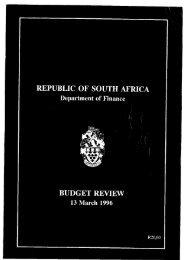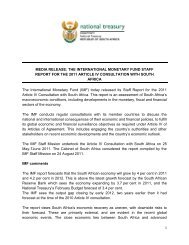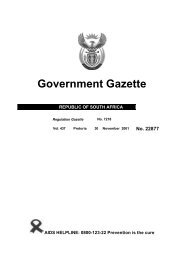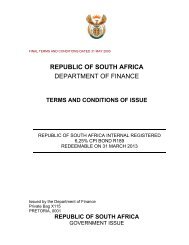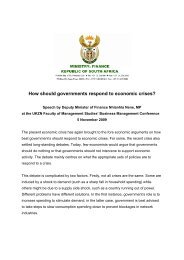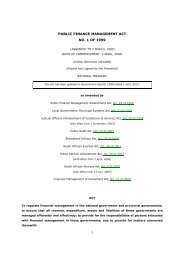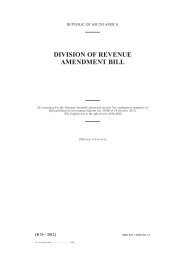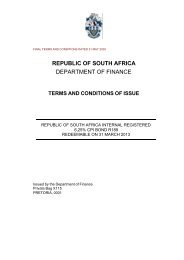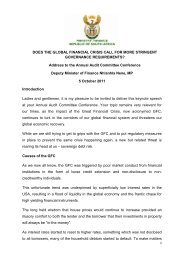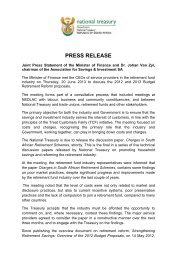1998 SOUTHERN AFRICA ECONOMIC ... - National Treasury
1998 SOUTHERN AFRICA ECONOMIC ... - National Treasury
1998 SOUTHERN AFRICA ECONOMIC ... - National Treasury
You also want an ePaper? Increase the reach of your titles
YUMPU automatically turns print PDFs into web optimized ePapers that Google loves.
S WA Z I L A N D<br />
The Lubombo Spatial Development Initiative<br />
The Lubombo Spatial Development Initiative (SDI),adjoining the<br />
M aputo development corr i d o r, is a partnership of the<br />
G overnments of Swaziland,South Africa and Mozambique and is<br />
expected to provide the necessary growth stimulus to the<br />
Lubombo are a .<br />
The main focal points include areas such as the Maputo Prov i n c e<br />
in Mozambique, the north-eastern parts of Kwa-Zulu Natal in<br />
South Africa and eastern Swaziland.The development initiative<br />
will open up unique opportunities to vast stretches of coastline<br />
(about 350km), w i l d l i fe covering over 300,000 ha of game<br />
re s e rves and significant agricultural deve l o p m e n t .The Lubombo<br />
SDI is viewed as complementing the Maputo corr i d o r, t h e re by<br />
c reating an exceptional investment zone. T h e re are plans to<br />
upgrade roads joining Richards Bay in South Africa and Map u t o ;<br />
and on the other hand, to improve the current N2 linking<br />
R i c h a rds Bay and Lavumisa/Namacha/Goba in Swaziland to<br />
accommodate future traffic vo l u m e.<br />
A number of transitional tourism projects offering integrated<br />
w i l d l i fe experiences are curre n t ly being developed in areas such<br />
as Nduma (joining Te m b e, F u t h i , Usuthu George and cove r i n g<br />
w i l d l i fe in all three countries), L av u m i s a - Po n gola project with<br />
o p p o rtunities for re c reation and leisure activities, Ko s i<br />
B ay / Ponto Do Ouro project offering opportunities for beach<br />
re s o rts and marina, and Hlane/Mlawula W i l d l i fe Zone.<br />
A l s o, various national projects have been deve l o p e d .T h e s e<br />
include the Greater St Lucia Wetland Park (South A f r i c a ) ,L a ke<br />
S i b ayi (South Africa) and nu m e rous others involving Swaziland<br />
and Mozambique.<br />
G overnments from all three countries have created SDI<br />
s t r u c t u res to co-ordinate overall activities pertaining to the<br />
Lubombo SDI. In order to accelerate participation by private<br />
i nvestors and the forging of strategic links with the public sector,<br />
priority has been given to an improved investment climate and<br />
the streamlining of investment pro c e d u re s .<br />
P r i v a t i s a t i o n<br />
The task of privatisation in Swaziland seems less daunting than<br />
in other SADC countries, due to the modest size of public<br />
ow n e r s h i p. In total, some 25 enterprises are either fully or<br />
m a j o r i t y - owned by gove r n m e n t , with a minority interest in<br />
some smaller companies.<br />
The process has been commenced by the commercialisation of<br />
Swaziland Railw ay s , and the restructuring of the Swaziland<br />
D evelopment and Savings Bank.The monopoly status granted to<br />
the Swaziland Royal Insurance Corporation will also be lifted,<br />
and the process of acquiring a strategic partner for the national<br />
a i r l i n e, R oyal Swazi A i r w ays has been ongoing for some time.<br />
F u rt h e r m o re, the restructuring of the Swaziland Post and<br />
Te l e c o m munications Corporation, a parastatal established in<br />
1 9 8 6 ,is on the card s .It is believed that the company will be split<br />
into a holding company with rights over the entire netwo r k<br />
s y s t e m ,and an operating company, which should be re s p o n s i b l e<br />
for providing serv i c e s .A dd i t i o n a l ly, p rovision will be made for a<br />
strategic partner to acquire a minority stake, including possibly<br />
the issue of a cellular license.<br />
The government has created a special monitoring unit, k n ow n<br />
as the Public Enterprises Unit, to evaluate the performance of<br />
specific enterprises, and to pre p a re them for commerc i a l i s a t i o n<br />
or privatisation.The stipulated enterprises are re q u i red by law<br />
to submit quart e r ly financial re p o rts to the unit, w i t h<br />
recommendation sent for sanctioning by the Cabinet.<br />
I N V E S T M E N T C L I M A T E<br />
I nvestment incentive s<br />
Highlights of the incentives include:<br />
The five - year tax exemption for new manufacturing companies<br />
i nvo l ved in exports has since been phased out. N ew tax<br />
re fo r m s ,to be implemented soon, a re aimed at reducing the<br />
l evel of corporate tax from 37.5 percent to 30 percent leading<br />
to 25 percent in the medium term. F u rther tax incentives are<br />
p re s e n t ly being considere d .<br />
An employee training programme allows for expenses incurre d<br />
in training personnel to be deducted for tax purposes.<br />
Assessed losses may be carried fo r w a rd and offset against future<br />
p ro f i t s .<br />
An initial depreciation allowance of up to 50 percent on plant<br />
and machinery may be claimed in the first year or spread ove r<br />
s everal ye a r s .<br />
A 10 percent local pre fe rence on public tenders is allowe d .<br />
An allowance is granted for the cost of building houses fo r<br />
e m p l oye e s .<br />
Business sites for industrial operations are available from the<br />
M i n i s t ry of Enterprise and Employment and Swaziland Industrial<br />
D evelopment Company (SIDC). O n going expansion of the<br />
M a t s apha Industrial and other sites is being carried out along<br />
with the upgrading of the country ’s infrastructure.<br />
E x p o rt In c e n t i ve s<br />
The Central Bank operates an Export Credit Guarantee<br />
Scheme established in 1991.The scheme includes pre- and postshipment<br />
loans granted by commercial banks, which re c e i ve<br />
guarantee bonds from the scheme as risk cove r. Swaziland has<br />
decided not to adopt the export processing zones concept.<br />
As a Lomé Convention signatory Swaziland enjoys pre fe re n t i a l<br />
access to the EU for a wide range of pro d u c t s . Under the GSP,<br />
Swaziland also has access to other major markets such as USA,<br />
C a n a d a ,Australia and Jap a n .<br />
Swaziland is a member of SAC U, which provides for the fre e<br />
m ovement of goods between the member countries (Botsw a n a ,<br />
L e s o t h o, N a m i b i a , South Africa and Swaziland). It is also a<br />
member of the regional organisations SADC and COMESA.<br />
Ta x a t i o n<br />
Corporate tax rate is 37.5 percent (will be reduced to 30<br />
p e rcent during 1999).<br />
M a x i mum rate for individual tax is 39 perc e n t .<br />
Withholding tax is at 15 percent (12.5 percent within SAC U ) .<br />
Double taxation agreements exist with South A f r i c a ,M a u r i t i u s<br />
and the United Kingdom.<br />
Institutions Invo l ved in Investment Pro m o t i o n<br />
Swaziland Industrial Development Corporation (SIDC), a<br />
j o i n t ly - owned by the government of Swaziland and five<br />
international development finance institutions, is the principal<br />
d evelopment finance institution. Its chief activities, t h e re fo re,<br />
i nvo l ve the provision of long-term loans, equity financing, a s s e t<br />
l e a s i n g ,acquisition of industrial land and buildings, and prov i d i n g<br />
technical advice and guidance to both local and international<br />
i nve s t o r s . Some of the projects that are like ly to re c e i ve<br />
s u p p o rt from the institution include the manu f a c t u r i n g ,m i n i n g ,<br />
a g ro - i n d u s t ry, t o u r i s m ,c o m m e rce and service sector.<br />
88



